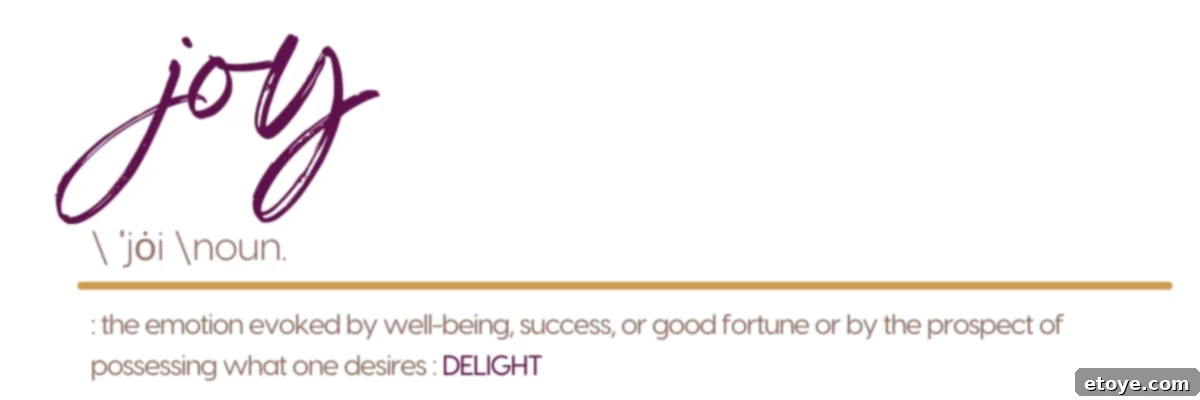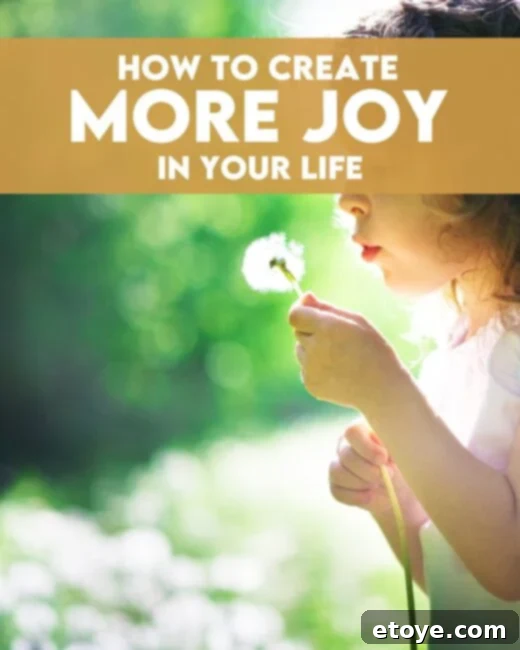Unlocking Your Inner Joy: A Comprehensive Guide to Cultivating Lasting Happiness
What truly comes to mind when you encounter the word “joy”? Is it a cherished memory, a profound feeling, or a vivid image of yourself in a particular place surrounded by specific people? The concept of joy is deeply personal, resonating uniquely within each of us. Before we delve into practical ways to infuse more joy into our lives, let’s take a moment to pause, breathe, and reflect on its personal significance.
Imagine a life where joy isn’t just a fleeting moment but a foundational state of being. This article serves as your guide to exploring, understanding, and actively cultivating that very state. We’ll uncover why joy is essential for overall well-being, how to define it for yourself, and actionable strategies to protect and prioritize it daily, helping you navigate life with greater ease and fulfillment.

What Does Joy Truly Mean to You?
While dictionaries offer standard definitions of joy, its essence is profoundly subjective. Each individual possesses a unique lens through which they perceive and experience joy, making its definition a deeply personal quest. For some, joy blossoms in the warmth of family gatherings and the laughter shared with friends. For others, it’s found in the quiet solitude of nature, the comforting presence of animals, the mindful act of cooking a delicious meal, or the simple pleasure of gardening in their backyard.
Joy is incredibly versatile; it can be sparked by a multitude of experiences and accessed through various means. The liberating truth is that joy is always accessible. It often requires nothing more than a conscious shift into an activity or a mindset that inherently evokes this positive state. More than just being “available,” joy is, in many respects, our natural state of being. This is most vividly observed in infants, toddlers, and young children, who radiate an effortless, abundant joy, reminding us of our own inherent capacity for delight.

The Innate Nature of Joy and How We Reclaim It
We enter the world brimming with an intrinsic inner joy. Babies burst into laughter at a funny face, find boundless delight in the simplicity of an empty box, a fascinating bug, or a loving smile from a parent. This list of simple joys for children is virtually endless, showcasing an uninhibited connection to the present moment. However, as we grow and interact with our environment, this natural state of being can unfortunately dim. Traumatic experiences, life’s hardships, societal pressures, and the overwhelming influence of our external world often lead us to lose touch with the core joy that is innate to all humans.
It’s also important to acknowledge that each brain is uniquely wired, influencing how we perceive and access joy. Yet, here lies the good news: we possess the inherent ability to harness and reintegrate joy back into our existence. By consciously choosing peace, healing, and joy in our daily lives, and by bringing a renewed sense of awareness and mindfulness to our moments, we can rekindle that vibrant inner light. Reclaiming joy is an active, conscious process that empowers us to restore our natural state of well-being, fostering a deeper connection to ourselves and the world around us.
The Profound Importance of Cultivating Joy
Beyond simply feeling good, cultivating joy has tangible and far-reaching benefits for our overall well-being. Extensive studies consistently demonstrate a powerful link between a joyful state of mind and improved health outcomes. Research, such as that highlighted by Harvard Health, indicates that individuals who live with a greater sense of joy and optimism tend to experience fewer health problems, boast a lower risk of depression, and enjoy longer, more fulfilling lives. Prioritizing and actively regulating our joyful state of being is not merely a luxury; it’s a fundamental component of elevating our entire health – encompassing our physical body, mental clarity, and spiritual vitality.
Moreover, joy acts as a crucial buffer against life’s inevitable challenges. When we cultivate a deep reservoir of inner joy, we become significantly more resilient to whatever difficulties life throws our way. This resilience allows us to navigate adversity with greater strength, a more positive outlook, and an unwavering sense of hope. It enables us to weather storms without being completely submerged, maintaining our inner equilibrium.
Joy vs. Happiness: Understanding the Distinction
It’s crucial to differentiate between joy and happiness, as they are often conflated but possess distinct characteristics. Happiness is typically situational; it’s a fleeting emotion triggered by external circumstances or positive events. We feel “happy” when we receive good news, enjoy a pleasant meal, or achieve a short-term goal. It is a temporary state, dependent on external factors and often comes and goes with the ebb and flow of daily life.
Joy, on the other hand, is a more profound and enduring inner state of being. It’s a deep-seated contentment, a sense of inner peace and fulfillment that can exist independently of external conditions. Joy is an underlying current that flows through us, even when life’s waters are turbulent. It’s the quiet acceptance, the inner strength, and the appreciation for simply being. The more adept we become at mastering this inner state of joy, the more frequently we will experience periods of happiness, peace, and calmness, even amidst life’s rocky seas. While we may have limited control over circumstances beyond our immediate reach, we possess immense power over how we allow those experiences to impact our inner state of being, making the cultivation of joy an empowering choice.

Defining Your Personal Joy Map: A Self-Exploration Journey
Given the deeply personal nature of joy, it’s essential to embark on a journey of self-exploration to truly understand what ignites this emotional state within you. This isn’t a one-size-fits-all endeavor; your joy map will be uniquely yours, reflecting your individual preferences, values, and experiences. To help you discover your personal sources of joy, consider asking yourself the following thought-provoking questions and spending time reflecting deeply on each answer:
- What activities do I naturally gravitate towards? Think about moments when you lose track of time, feel fully absorbed, and experience a sense of effortless engagement. This could be anything from reading a captivating book, hiking in nature, painting, playing a musical instrument, or engaging in a cherished hobby. What makes your spirit feel light and free?
- What genuinely brings me happiness and a sense of fulfillment? Go beyond superficial pleasures. What are the core experiences, relationships, or achievements that leave you with a lasting sense of contentment and an inner glow? Consider moments of deep connection, personal accomplishment, or meaningful contribution.
- When do I feel most authentically myself and at peace? Identify the environments, people, or situations where you feel completely unburdened, genuine, and harmonious. These moments often reveal where your true spirit thrives, where you can shed pretenses and simply exist as you are.
- What triggers me to be OUT of joy? What consistently causes me stress, anger, or sadness? Understanding the inverse is just as crucial. Pinpointing what depletes your joy, creates tension, or leads to negative emotions will provide invaluable insight into establishing healthier boundaries and making conscious choices to protect your inner peace and emotional well-being.
By exploring both what cultivates joy and what creates its opposite effect, you develop a comprehensive awareness of the factors that can throw you off balance. Life is inherently imperfect, and challenges are inevitable. However, the better we understand ourselves in moments of low energy or negative emotion, the better equipped we become to set clear boundaries around those activities and situations, and to remain more present in our positive, joyful state. This self-awareness is the first, most powerful step towards empowered living and sustained inner peace.

Strategic Tips for Setting Boundaries and Prioritizing Joy
As previously highlighted, our inner joy can be significantly impacted by our external world if we allow it to dictate our internal experience. A substantial part of navigating this complex interplay involves understanding precisely how to establish and maintain your own unique boundaries and priorities. This empowers you to consistently return to a state of joy, even when life presents its inevitable bumps and detours, ensuring that your well-being remains safeguarded.
Here are some powerful strategies for effectively prioritizing your joy and safeguarding your well-being:
1. Understand Your Stressors: The Root of Discomfort
Gaining a thorough and honest understanding of the specific triggers that lead to stress, complications, and negative emotions is fundamental to protecting your joy. This awareness serves as your personal radar, helping you anticipate their effects and prepare a proactive response. By identifying your stressors – whether they are certain people, demanding work situations, unrealistic self-expectations, overwhelming environments, or even specific thought patterns – you can begin to formulate an action plan. This might involve strategically reducing your exposure to these triggers, or, when exposure is unavoidable, improving your emotional and practical reaction to them through mindfulness or coping techniques. Start by keeping a journal or taking notes whenever something occurs that disrupts your sense of joy. This consistent practice will significantly enhance your awareness of these external influences and help you develop more effective, personalized management strategies.
2. Conduct a Comprehensive Life Audit: Mapping Your Joy-O-Meter
Take a holistic look at various facets of your life to gauge where your joy resides and where it might be lacking. Examine your relationships (family, friends, romantic partners), your career or job satisfaction, your living situation, your daily activities and hobbies, your nutrition, and critically, where and how you spend your precious time and energy. For each category, tune into your “joy-o-meter”—a metaphorical gauge of how much joy and fulfillment you derive from it. Conduct a thorough audit to pinpoint areas where you can actively inject more joy and, equally important, identify where your joy is being consistently drained. This audit is not about judgment, but about informed decision-making to reallocate your resources towards greater well-being, fostering environments and activities that genuinely uplift you.
3. Establish Clear and Loving Boundaries: Your Personal Protection System
What exactly does it mean to set boundaries? Boundaries are essential limits that we define for ourselves and clearly communicate to those around us regarding what we are willing to allow into our lives, and what we are not. These are, in essence, mini-promises you make to yourself to prioritize your peace, well-being, and, crucially, your joy. Once you’ve understood your stressors and completed your life audit, you can begin to identify specific instances where you need to say “no,” make changes, adapt your approach, or restrict certain influences from entering your reality. After establishing a clear internal understanding of your boundaries, the next vital step is to communicate them with love, clarity, and peace to those in your life. Remember, boundaries are not ultimatums or demands like, “You must do this.” We cannot control the actions or choices of other people. Our power lies solely in controlling what we choose to be a part of, and what we choose to protect ourselves from, fostering respectful interactions based on mutual understanding.
4. Uphold Your Boundaries with Conviction: The Path to Self-Trust
For those unaccustomed to setting boundaries, the process can initially feel foreign, uncomfortable, or even selfish. However, the reality is quite the opposite! Upholding your boundaries is a profound act of self-care and self-respect. The more consistently you honor your needs and protect your energetic space, the more “full” your own cup will become. And paradoxically, a full cup enables you to contribute more authentically, generously, and joyfully to those around you, without depletion or resentment. This practice cultivates genuine connection, as it allows you to engage from a place of abundance rather than obligation.
Setting boundaries and staying true to them is a transformative practice. It fosters greater self-trust, liberates your valuable time and energy, solidifies your commitment to peace and joy, and ultimately enhances your overall happiness by ensuring that only what truly aligns with your well-being is allowed into your daily experience. This is not about building walls, but about creating healthy filters that allow you to thrive, promoting healthier relationships with yourself and others.
Daily Practice for Infusing More Joy into Your Life
Armed with self-awareness and boundary-setting strategies, it’s now time to translate these insights into tangible action. The most effective way to ensure joy remains a constant in your life is to create your own personalized “joy list.” This list serves as a quick reference tool for those days when you’re not feeling your best, providing immediate, accessible ways to uplift your spirits and shift your mindset. It’s your personal arsenal against gloom.
Once created, display this list prominently where you can see it every single day – perhaps on your fridge, by your bedside, or as your phone’s wallpaper. This constant visual reminder will ensure that when you need to stimulate more joy, you’ll instantly know exactly what to do. Your joy list might include simple acts like listening to your favorite uplifting song, taking a short mindful walk, calling a loved one, spending five minutes in nature, sipping a warm cup of herbal tea, engaging in a quick creative activity, or even just stretching.
Want to elevate this practice and truly embed more joy into the fabric of your life? Take a look at your compiled joy list and consciously pick just one thing each day that you feel called to do. Integrate this small, joyful act into your morning or night routine, or even a lunch break. The consistency of these small acts, performed mindfully and intentionally, creates a cumulative effect that profoundly impacts your overall state of being, gradually rewiring your brain for more positive experiences. It’s about making joy a non-negotiable part of your daily rhythm, cultivating a habit of happiness that sustains you.
My Personal Joy List (Example)

Share Your Journey to Joy with Us!
The journey to cultivating joy is both universal and deeply personal. It’s a continuous process of discovery, introspection, and intentional action. What ignites your spirit and brings you profound joy? We are eager to hear about your unique discoveries and the practices that help you sustain your inner light! Please share some of the items from your personal joy list with us in the comments section below. Your insights and experiences can inspire and uplift others on their own path to a more joyful, peaceful, and fulfilling life. Let’s create a community of joy-seekers!
